监测期涵盖了冬小麦的收获期(主要在7月结束)、玉米和水稻的生长期和收获期以及9月至10月的冬小麦播种期。在全国范围内,降水量低于平均水平(-54%),平均气温(+ 1.1℃)和光合有效辐射(+ 2%)均高于过去15年同期平均水平。潜在生物量比平均水平偏低6%。耕地种植比例上涨了3%,表明耕种的土地面积增加。
基于NDVI的作物生长过程线表明,在整个监测期内,作物生长状况均略低于平均水平。全国最佳植被状况指数(VCIx)的平均值为0.78。土耳其只有少数地区(主要包括克尔克拉雷利、伊斯坦布尔、穆斯、伊格迪尔、西马克、通杰利和约兹加特等省)的最佳植被状况指数值高于1.0,表明这些地区的作物生长状况优于同期最佳水平。位于中西部的大多数省份,例如克尔克拉雷利、阿菲永卡拉希萨尔和科尼亚省,最佳植被状况指数值较低(<0.5),表明作物生长状况劣于平均水平。
NDVI距平空间聚类图的空间分布证实了上面叙述的VCIx的空间格局。基于植被健康状况指数的干旱等级统计图所示,在监测期末,经历了轻度到重度干旱的耕地面积比例已增加到大约40%。 总体而言,在整个监测期内,大多数地区都经历了不同程度的干旱。作物产量预计将略低于平均水平。
区域分析
区域分析的部分包括四个农业生态区:黑海地区、中部安纳托利亚地区、东部安纳托利亚地区和马尔马拉海、爱琴海、地中海地区。
在黑海地区,作物生长状况件总体劣于平均水平。降水量低于平均水平(-46%),而平均气温升高了1.2℃。耕地种植比例的平均值为95%,在土耳其四个农业生态区中是最高的。复种指数处于平均水平。VCIx的平均值很高(0.87),也是所有四个农业生态区中最高的。作物生长状况评估为正常。
在此监测期内,中部安纳托利亚地区的作物生长状况总体劣于平均水平。在此监测期内,该农业生态区的降水量较过去15年同期平均水平的降幅最大(-64%),平均气温(+ 1.4℃)和光合有效辐射(+3%)均高于平均水平。潜在生物量略有下降(-7%)。复种指数处于平均水平。该区域的平均VCIx值为0.74,在四个农业生态区中是最低的。耕地种植比例略有增加(+2%)。作物生长状况被评估为略低于平均水平。
在东部安纳托利亚地区,从7月中旬到9月初,作物生长状况优于平均水平,然后在10月降至平均水平以下。平均气温和光合有效辐射分别比平均水平高0.7℃和1%,而降水量则低于平均水平(-46%)。 潜在生物量增长了9%,是四个农业生态区中最大的涨幅。与平均水平相比,耕地种植比例增加了8%。复种指数较近5年同期平均水平偏低6%,为四个农业生态区中的最大变幅。VCIx平均值为0.85,作物前景向好。
如基于NDVI的作物生长过程线所示,在整个监测期内,马尔马拉海、爱琴海、地中海地区的作物生长状况劣于近5年同期平均水平。降水量低于平均水平58%,平均气温略高于平均水平(+1.1℃)。复种指数稍有偏高(+1%)。VCIx值为0.75,耕地种植比例增长2%。预计该地区的作物前景将劣于或接近平均水平。
图 3.40 2020年7月-10月土耳其作物长势

(a). 主要作物物候历
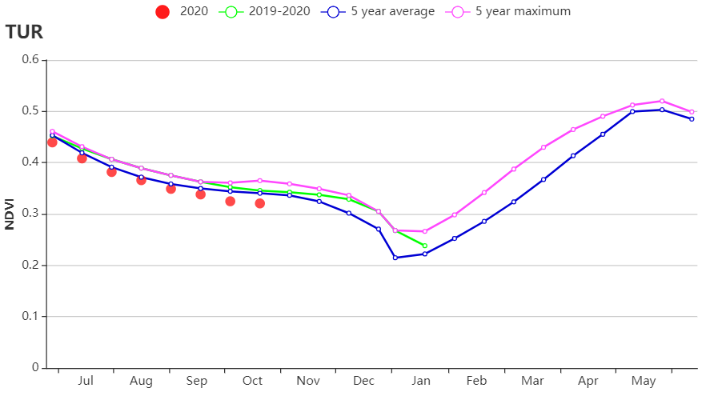
(b) 基于NDVI的作物生长过程线

(c) 最佳植被状况指数
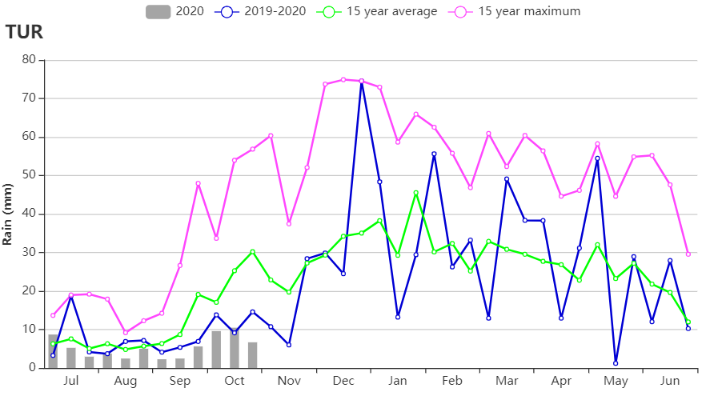
(d) 降水量时间序列过程线
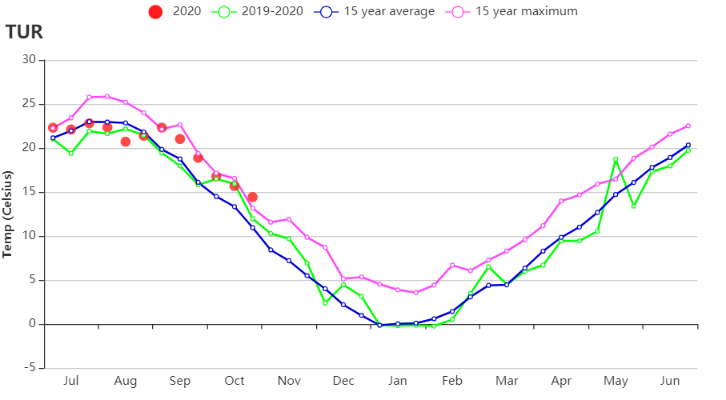
(e) 平均气温时间序列过程线

(f) NDVI距平空间聚类图(与5年平均相比) (g) NDVI距平聚类过程线

(h) 基于NDV的作物生长过程线 (黑海地区)
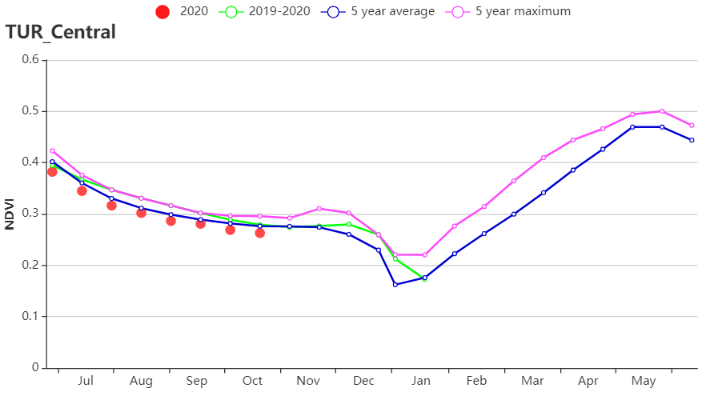
(i) 基于NDV的作物生长过程线 (中部安那托利亚地区)
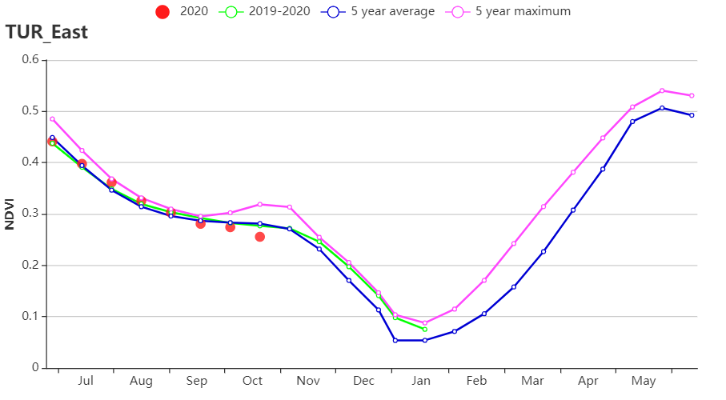
(j) 基于NDV的作物生长过程线 (东部安那托利亚地区)
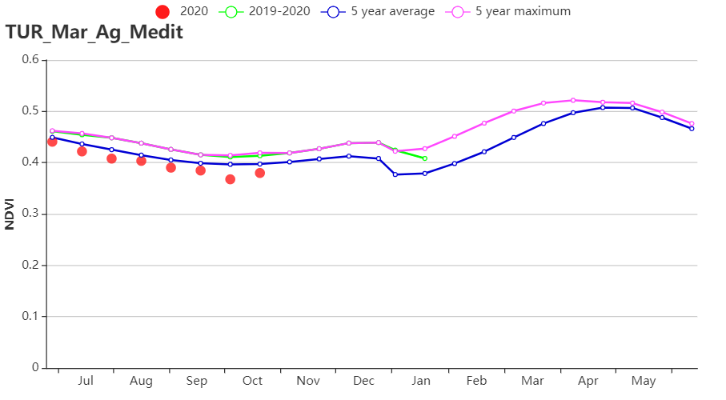
(k) 基于NDV的作物生长过程线 (马尔马拉海、爱琴海和地中海地区)
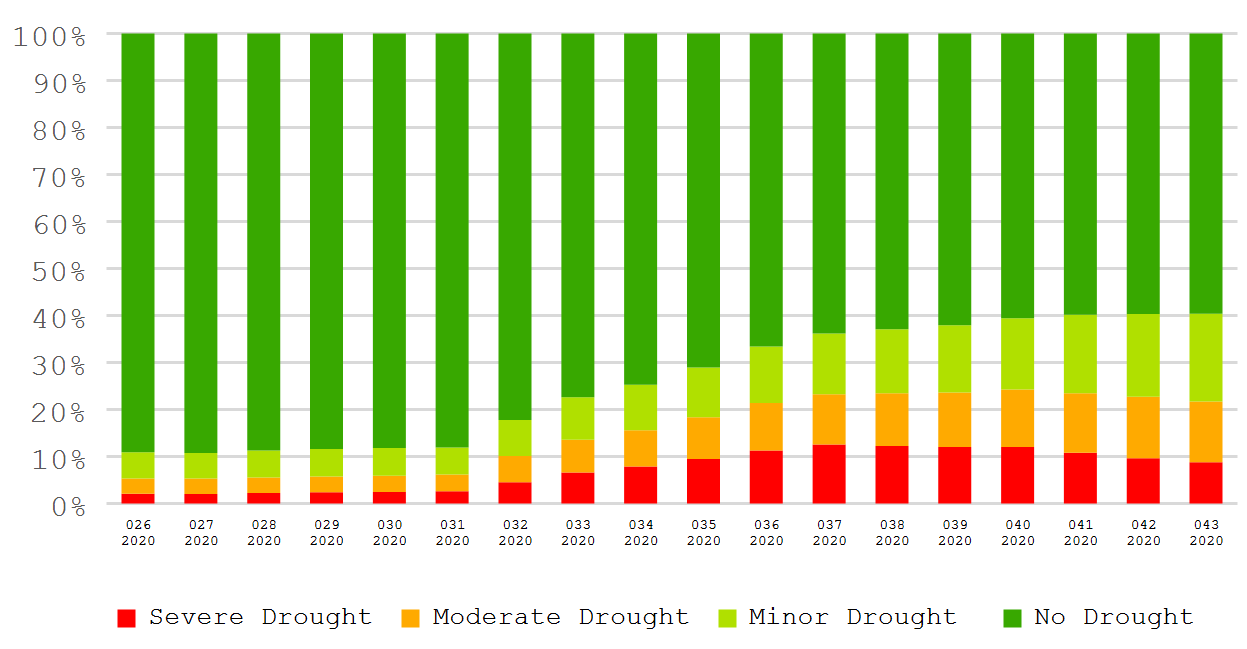
(l) 基于VHI的干旱等级统计图
图3.71. 土耳其农业生态分区2020年7月-10月与过去15年(15YA)同期农业气象指标
| 累积降水 | 平均气温 | 光合有效辐射 | 累积潜在生物量 | |||||
| 当前值 (mm) | 距平 (%) | 当前值 (°C) | 距平(°C) | 当前值 (MJ/m2) | 距平 (%) | 当前值 (gDM/m2) | 距平(%) | |
| 黑海地区 | 155 | -46 | 16.4 | 1.2 | 1164 | 5 | 495 | 6 |
| 中部安那托利亚地区 | 40 | -64 | 19.3 | 1.4 | 1314 | 3 | 466 | -7 |
| 东部安那托利亚地区 | 80 | -46 | 18.1 | 0.7 | 1326 | 1 | 422 | 9 |
| 马尔马拉海、爱琴海、地中海地区 | 52 | -58 | 22.7 | 1.1 | 1326 | 1 | 393 | -16 |
图3.72. 土耳其农业生态分区2020年7月-10月与近5年(5YA)同期农情指标
| 耕地种植比例 | 复种指数 | 最佳植被状况指数 | |||
| 当前值(%) | 距平(%) | 当前值 (%) | 距平(%) | ||
| 黑海地区 | 95 | 0 | 102 | 0 | 0.87 |
| 中部安那托利亚地区 | 36 | 2 | 103 | 0 | 0.74 |
| 东部安那托利亚地区 | 53 | 8 | 101 | -6 | 0.85 |
| 马尔马拉海、爱琴海、地中海地区 | 58 | 2 | 108 | 1 | 0.75 |
